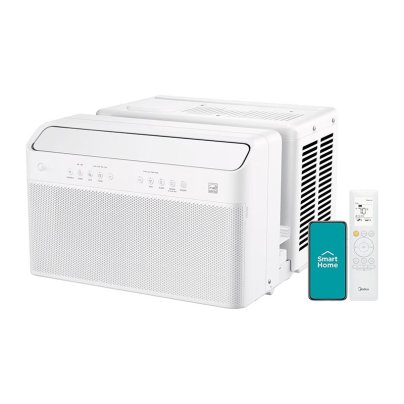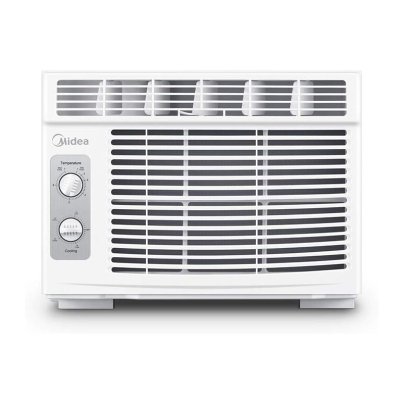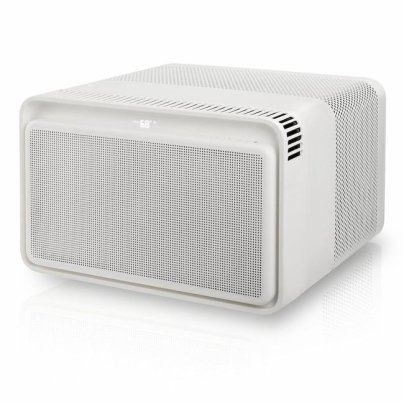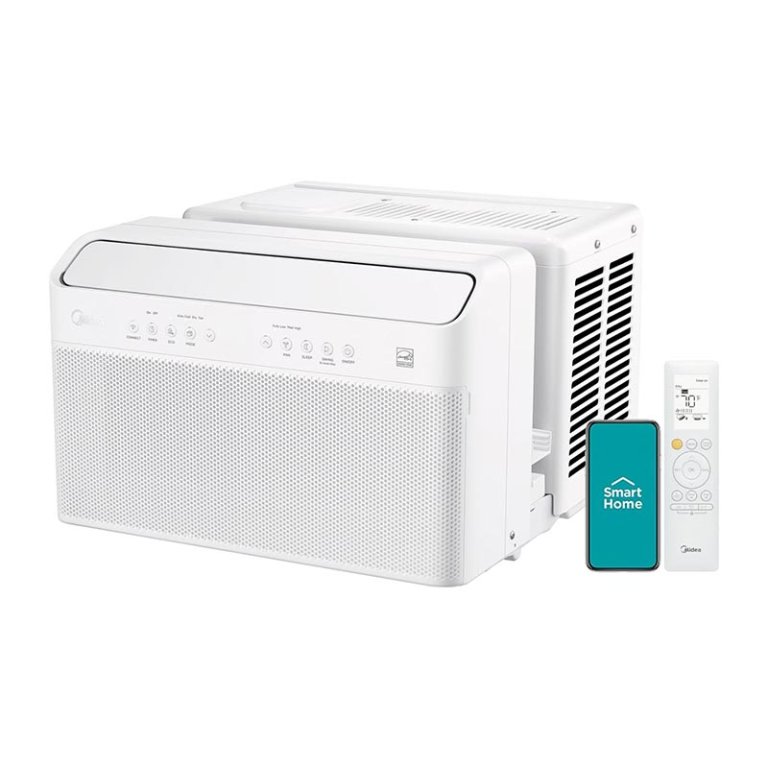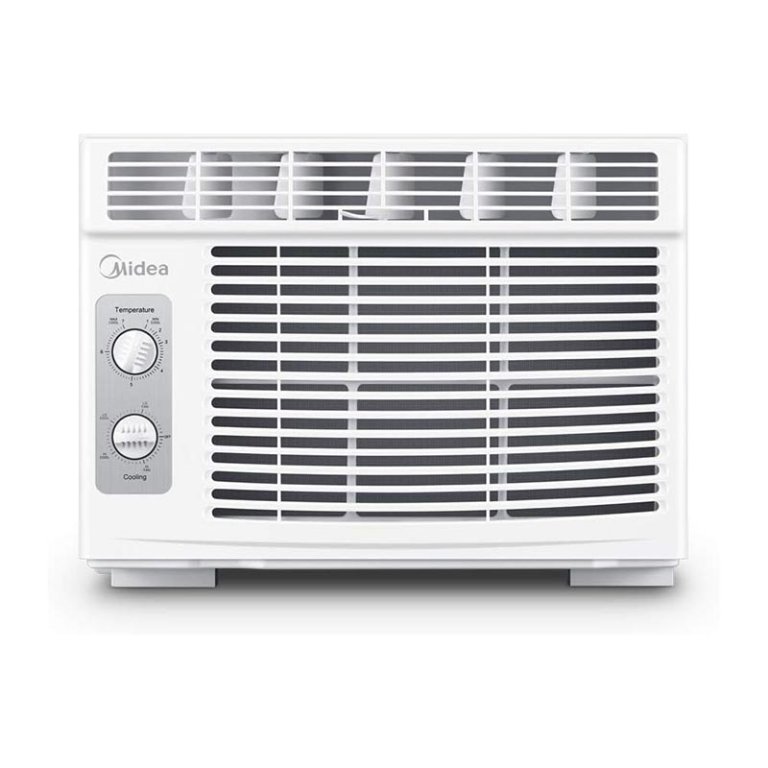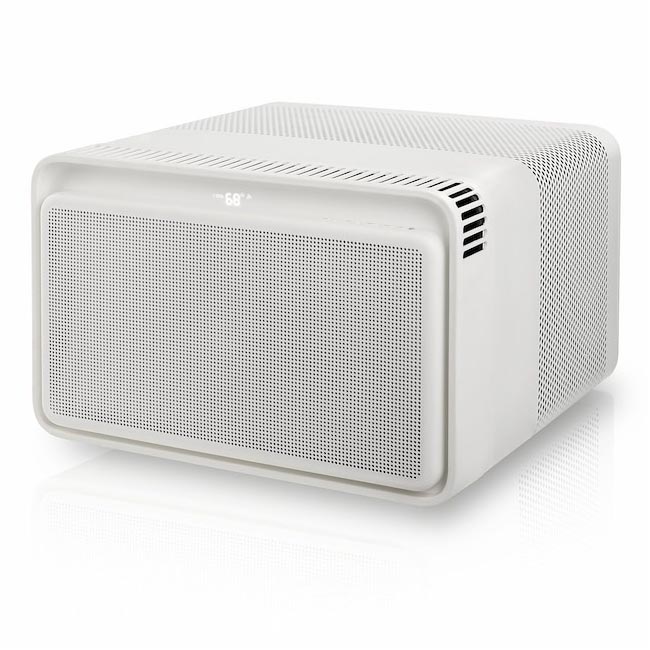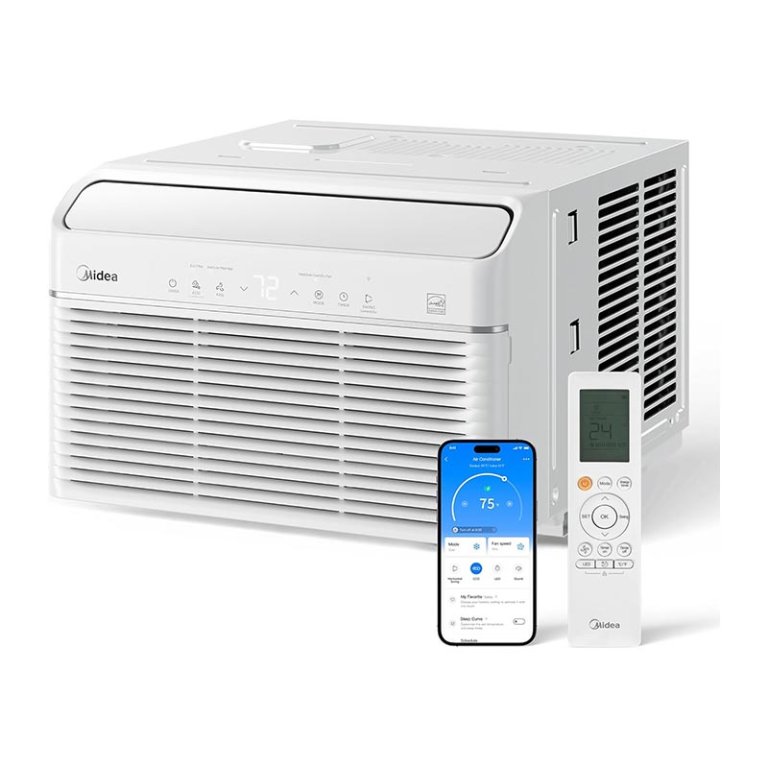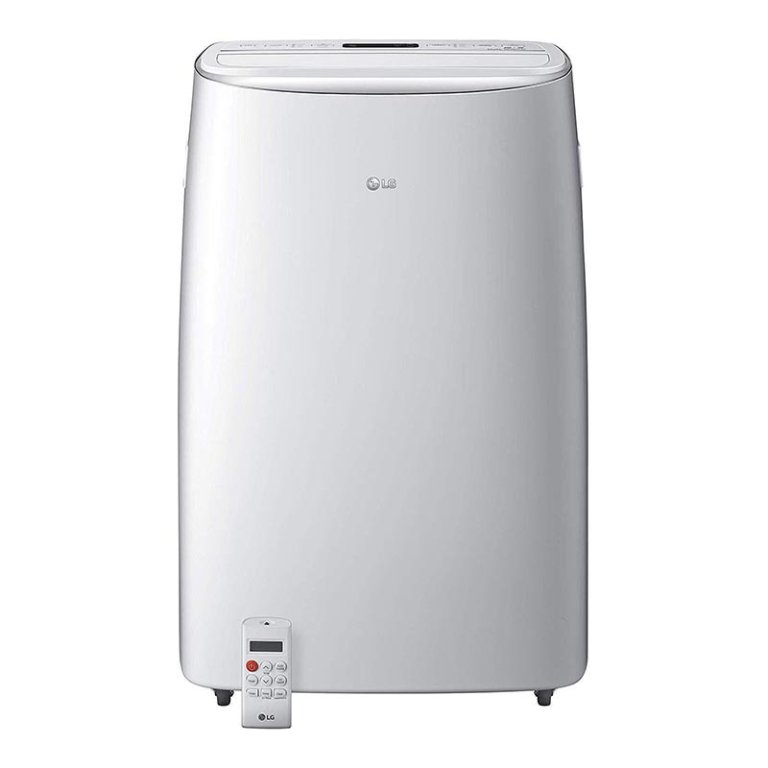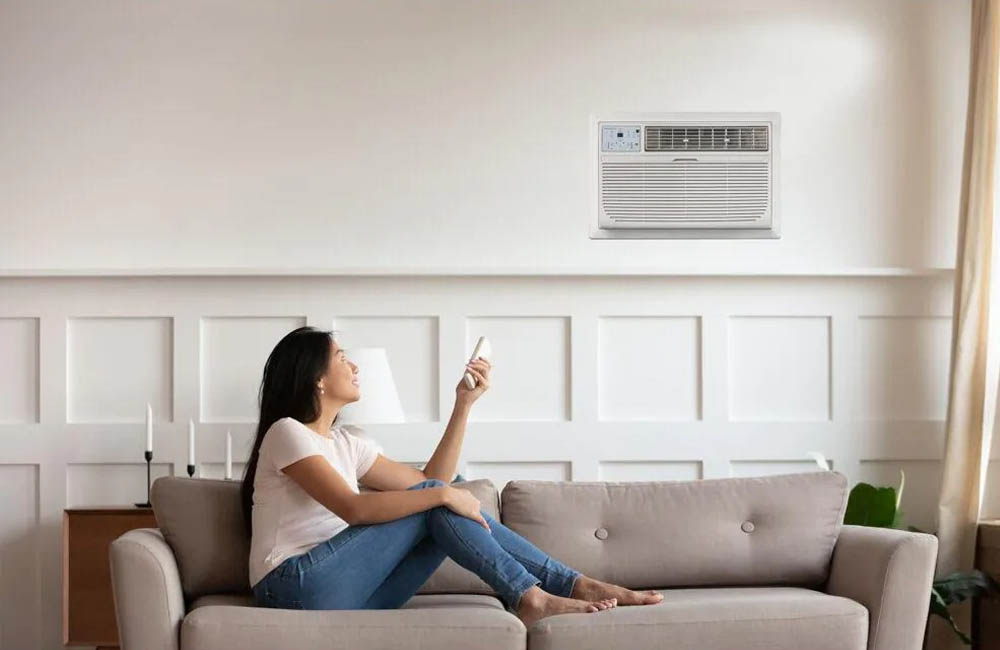
We may earn revenue from the products available on this page and participate in affiliate programs. Learn More ›
In many regions, an air conditioner is a must-have for surviving hot and muggy summers, but a good air conditioning unit can be quite the investment, especially if central air isn’t a feature of your home’s heating and cooling system. It’s a decision that matters, so we ran these air conditioners through a series of tests to check how well they worked and how loudly they ran.
The right pick should be able to last through the seasons, have a suitable cooling capacity, and have a comfortable (or at least tolerable) noise level. Quality air conditioner units can cool a room or an entire home quickly and efficiently, providing sweet relief from the summer heat. Our top pick is the Midea 8,000 BTU U-Shaped Air Conditioner. It’s highly energy efficient due to its U-shaped design and allows the window to close so that the view—and not the air conditioner—takes center stage. Read on for the best air conditioner models that will help you stay cool all summer long.
- BEST OVERALL: Midea 8,000 BTU U-Shaped Air Conditioner
↓ Jump to Review - BEST BANG FOR THE BUCK: Midea 5,000 BTU Window Air Conditioner
↓ Jump to Review - BEST WINDOW: The Windmill AC Smart Inverter Air Conditioner
↓ Jump to Review - BEST PORTABLE: Whynter ARC-14S 14,000 BTU Portable Air Conditioner
↓ Jump to Review - BEST FOR LARGE ROOMS: Midea 12,000 BTU U-Shaped Air Conditioner
↓ Jump to Review - ALSO CONSIDER: LG 10,000 BTU Dual Inverter Portable Air Conditioner
↓ Jump to Review

Air Conditioners Comparison Chart
| Product | BTU Rating | Room Size | Combined Energy Efficiency Rating (CEER) |
|---|---|---|---|
| Midea 8,000 BTU U-Shaped Air Conditioner | 8,000 | 350 square feet | 15 |
| Midea 5,000 BTU Window Air Conditioner | 5,000 | 150 square feet | 12.1 |
| The Windmill AC Smart Inverter Air Conditioner | 8,000 | 350 square feet | 11.6 |
| Whynter ARC-14S 14,000 BTU Portable Air Conditioner | 14,000 | 500 square feet | 7.69 |
| Midea 12,000 BTU U-Shaped Air Conditioner | 12,000 | 550 square feet | 15 |
| LG 10,000 BTU Dual Inverter Portable Air Conditioner | 10,000 | 500 square feet | 7.9 |
Our Top Picks
Installing an air conditioner is the best way to beat the summer heat. The following air conditioners were chosen based on research and hands-on testing for their efficiency, output, and reasonable noise level to keep a home comfortable in sweltering weather.
Best Overall
Midea 8,000 BTU U-Shaped Air Conditioner
What We Like
- Allows more light than typical window air conditioners
- Windows can still be opened after installation
- Compressor is outside for quiet operation
- Clean, modern design doesn’t stick out
What We Don’t Like
- Installation is not straightforward
Specs
- BTU rating: 8,000
- Room size: 350 square feet
- Combined Energy Efficiency Rating (CEER): 15
Our Ratings: Installation 3.5/5; Performance 5/5; Noise 5/5; Ease of Cleaning 4/5; Value 5/5
With its innovative U-shaped design, this Midea air conditioner is more energy efficient and quieter than standard window units. While standard units require the window to be open a foot or more, the Midea straddles the window, allowing the window to close between the blower and compressor. With a tighter seal between the window and the outside, this unique model is 35 percent more energy efficient than traditional window air conditioners.
This U-shaped air conditioning unit also eliminates excessive noise, as the compressor sits outside. With the noisy compressor on the other side of the glass, this room air conditioner produces 42 decibels (dB), which is only slightly noisier than a library. To top off its great design, it includes sleep, energy saver, and auto shutoff modes to further improve efficiency. Plus, it’s also a smart device, capable of connecting to a home’s Wi-Fi for control via a smart device or virtual assistant for cooling control on demand.
The control panel is straightforward, and using the remote is a snap. The Wi-Fi app was simple to set up and connect as well, and we actually found that to be the easiest control method for this AC. The Midea has a few more perks, too. Its design allows more light into the room than typical window air conditioners, and we liked that we could tuck our curtains behind it for more privacy. Needless to say, we’re believers in U-shaped air conditioners now.
What our tester says: “Though installation certainly took some effort—it comes with several small components and hardware—once installed, this AC window unit was easy to enjoy. It was so quiet that it was barely noticeable, and it cooled my room by 5 degrees Fahrenheit in just 15 minutes.”–Tom Scalisi, Product Reviews tester and writer
Get the Midea 8,000 BTU air conditioner at Amazon, Lowe’s, or Walmart.
Best Bang for the Buck
Midea 5,000 BTU Window Air Conditioner
What We Like
- Compact and easy to install in small windows
- Cools rooms up to 150 square feet
- Simple 2-knob control; easy setup and operation
- Decent CEER rating at an affordable price
What We Don’t Like
- Louver adjustments only adjust side to side
Specs
- BTU rating: 5,000
- Room size: 150 square feet
- Combined Energy Efficiency Rating (CEER): 12.1
Our Ratings: Installation 5/5; Performance 4/5; Noise 4/5; Ease of Cleaning 4/5; Value 4/5
A high-quality air conditioner doesn’t need to come with a luxury price tag, as proven by this compact window unit from Midea. This small 5,000 BTU cheap air conditioner suits rooms up to 150 square feet, ideal coverage for keeping a small bedroom or office cool, or for use as a personal air conditioner. With its mini size, it’s easy to install. Plus, mounting hardware is included, and installation requires minimal modifications to the window frame, making it an excellent option for renters.
Once installed, this indoor air conditioner has a reasonably efficient CEER rating of 12.1, so it won’t put a huge dent in utility bills. Ongoing maintenance is also simple—it includes a reusable, washable filter to minimize maintenance costs. The air conditioner operates at around 56 dB, so it won’t be too loud and might offer a bit of white noise for light sleepers. It’s simple to use, with just two knobs to adjust.
During our test, we found that this Midea was extremely easy to install, thanks to its lighter weight at just 42.1 pounds (compared to 55.55 pounds for the model above). We just had to open the window, pop it in, and lower the sash before adjusting the side panels. It also cooled the small bedroom we placed it in quickly, and although it’s not the quietest model on the list, it’s far from loud. The louvers are a little one-dimensional as they only adjust side to side, not up and down, but overall, that’s a small complaint for an AC this affordable.
Get the Midea 5,000 BTU air conditioner at Amazon, Lowe’s, Wayfair, or Walmart.
Best Window
The Windmill AC Smart Inverter Air Conditioner
What We Like
- Runs as quietly as 42 dB
- Modern design with foam side panels
- Compatible with Alexa, Google Assistant, or the Windmill app
What We Don’t Like
- Less efficient than some other inverter-type air conditioners
Specs
- BTU rating: 8,000
- Room size: 350 square feet
- Combined Energy Efficiency Rating (CEER): 11.6
Our Ratings: Installation 4/5; Performance 3.5/5; Noise 5/5; Ease of Cleaning 4/5; Value 4/5
Anyone hunting for a window unit that looks good and keeps the noise to a minimum will want to consider The Windmill 8,000 BTU smart air conditioner. This model features a modern design that looks great in the window, and it comes with solid foam side panels that are customizable for a clean look. These panels also help, along with the inverter technology, to keep this unit quiet, running at noise levels as low as 42 dB.
The Windmill has several features, including a digital remote control and a clean control panel on the front of the air conditioner. It’s also compatible with Amazon Alexa, Google Assistant, or The Windmill app. It’s not quite as efficient as other inverter air conditioners, but it’s not a utility sapper either.
During our test, we liked the look of The Windmill. First, it has a clean, modern style that doesn’t detract from the interior of the home. Then, rather than flimsy accordion side panels, the foam covers really clean up the look. On top of that, it was very quiet, and rather than blowing air straight out, it pointed it upward to better facilitate the cooling process.
Get The Windmill air conditioner at Lowe’s, The Home Depot, Wayfair, or Walmart.
Best Portable
Whynter ARC-14S 14,000 BTU Portable Air Conditioner
What We Like
- Wheeled design; simple to move around
- 3 operating modes (cool, fan, or dehumidify)
- Dual-hose design increases airflow
What We Don’t Like
- At 73 pounds, this unit is quite heavy
- The CEER rating is fairly low
Specs
- BTU rating: 14,000
- Room size: 500 square feet
- Combined Energy Efficiency Rating (CEER): 7.69
Our Ratings: Installation 3/5; Performance 3.5/5; Noise 3.5/5; Ease of Cleaning 5/5; Value 4/5
This 14,000 BTU portable unit from Whynter is a mobile and powerful pick to cool down rooms of up to 500 square feet. It features three operating modes (cool, fan, or dehumidify) to keep indoor air comfortable. A dual-hose design allows for a separate intake and exhaust hose, increasing airflow and efficiency to provide quick cooling. Convenience features include a simple setup, a 24-hour programmable timer, and a filter system with a prefilter and activated-carbon filter.
Maintaining this AC unit is easy. Auto-draining technology helps drain condensation automatically, and a washable prefilter is easy to clean to keep the air fresh. Running at around 56 dB, this air conditioner is reasonably quiet for a portable unit. However, it’s also quite heavy, weighing 73 pounds, so it may be best for 1-floor homes. It also has a very low CEER of just 7.69.
While it’s a bit of an armful, we found that the wheels on this stand-up air conditioner were a big help with moving it about. It set up quickly in our 600-square-foot room (slightly larger than it’s rated for), and it had the ability to cool the room in just 10 minutes. We also appreciated its slim design, a great difference from bulkier, more traditional portable air conditioners.
Get the Whynter air conditioner at Amazon, The Home Depot, Wayfair, or Walmart.
Best for Large Rooms
Midea 12,000 BTU U-Shaped Air Conditioner
What We Like
- U-shaped design keeps noise outside
- Included brackets are very secure
- App is easy to use
- Remote has a built-in digital screen
What We Don’t Like
- Comparatively heavy at 58.86 pounds
Specs
- BTU rating: 12,000
- Room size: 550 square feet
- Combined Energy Efficiency Rating (CEER): 15
Our Ratings: Installation 3.5/5; Performance 5/5; Noise 5/5; Ease of Cleaning 4/5; Value 4.5/5
Those in search of a quiet air conditioner with the power to cool larger rooms may want to consider the Midea 12,000 BTU window air conditioner. Like the 8,000 BTU model listed above, it also features a U-shaped design, so most of the noise remains outside. It can run noticeably quieter on the inside while still cooling rooms up to 550 square feet in size. It also has three modes from which to choose, including fan, cool, and dehumidifier.
This unit comes with a bracket that adjusts to fit the window and the house, as well as various foam pieces of different thicknesses to seal out noise and the elements. It includes a remote control, a downloadable app, and Wi-Fi compatibility.
We found that this 12,000 BTU U-shaped air conditioner quickly, efficiently, and quietly cools large rooms. It sits on the same bracket as the smaller units, so it installs securely, though it is pretty heavy at nearly 60 pounds. The app and remote control are very easy to use, and when the unit kicks on, it’s barely noticeable unless you feel the breeze. We loved that it allowed plenty of light in around the air conditioner and that we could open the window if we wanted to.
Read our full review: Midea 12,000 BTU U-Shaped Air Conditioner
What our tester says: “I found that, without a doubt, the Midea is the best-designed window air conditioner I’ve ever installed or used. Yes, it’s heavy, and the bracket takes a bit of time to install, but once it’s done, it does away with any fear the user might have regarding safety or security.”–Tom Scalisi, Product Reviews tester and writer
Get the Midea 12,000 BTU air conditioner at Amazon or Lowe’s, or Walmart.
Also Consider
LG 10,000 BTU Dual Inverter Portable Air Conditioner
What We Like
- Easy to roll from room to room
- Controls with included remote or with app
- Runs reasonably quiet at about 60 dB
What We Don’t Like
- No built-in condensation evaporator
Specs
- BTU rating: 10,000
- Room size: 500 square feet
- Combined Energy Efficiency Rating (CEER): 7.9
Our Ratings: Installation 5/5; Performance 3.5/5; Noise 3.5/5; Ease of Cleaning 3/5; Value 4/5
When it comes to cooling rooms without back-breaking window-unit installation, the LG 10,000 BTU air conditioner might be the best option. This portable unit features smooth rolling wheels so you can move it from room to room easily, as well as an extendable hose and window vent that allow it to work in almost any window. While it’s not considered an energy-efficient air conditioner (7.9 CEER), it does have the output to cool up to a 500-square-foot room.
This free-standing air conditioner has plenty of built-in features, including a digital remote control and Wi-Fi compatibility. You can cycle through the different settings or set timers with the remote or the LG ThinQ app, or you can use Google Assistant or Amazon Alexa.
Portable air conditioners are always fairly easy to set up, and we found this model took the cake during testing. The window panel snapped together in seconds, and the hose locked in place, allowing us to install it in less than a minute without any heavy lifting. It was very quiet for a 10,000 BTU AC (we measured it at 60 dB), and the app and remote were easy to use. The biggest downside is that we had to drain the condensation from under the unit, which required a shallow cookie sheet.
Get the LG air conditioner at Lowe’s, The Home Depot, Best Buy, or Walmart.
Jump to Our Top Picks
How We Tested the Best Air Conditioners
| Testing Stats | |
| Products tested | 8 |
| Time spent testing | Several months |
| Tests performed | 5 to 6 |
| Price range | $160 to $650 |
No one wants to spend money on an air conditioner only to find out that it’s low quality—that’s totally not cool. So we spent months testing the air conditioners on this list to ensure we knew how well they would work and that they’d be up to the task.
We tested these units in several different ways. We compared how easy they were to install, how loud they were, how well they cooled, and then how well any smart functions or additional features worked. We evaluated how quickly they cooled rooms on the hottest days of the year and how well they handled sticky humidity. Some models couldn’t quite cut it (either they were too loud, too heavy, too basic, or not effective), so we did not place them on the list. However, all of the included best air conditioner picks excelled in particular areas and were given awards based on their strengths.
| Product | Installation | Performance | Noise | Ease of Cleaning | Value |
| Midea 8,000 BTU U-Shaped Air Conditioner | 3.5/5 | 5/5 | 5/5 | 4/5 | 5/5 |
| Midea 5,000 BTU Window Air Conditioner | 5/5 | 4/5 | 4/5 | 4/5 | 4/5 |
| The Windmill AC Smart Inverter Air Conditioner | 4/5 | 3.5/5 | 5/5 | 4/5 | 4/5 |
| Whynter ARC-14S 14,000 BTU Portable Air Conditioner | 3/5 | 3.5/5 | 3.5/5 | 5/5 | 4/5 |
| Midea 12,000 BTU U-Shaped Air Conditioner | 3.5/5 | 5/5 | 5/5 | 4/5 | 4.5/5 |
| LG 10,000 BTU Dual Inverter Portable Air Conditioner | 5/5 | 3.5/5 | 3.5/5 | 3/5 | 4/5 |
What to Consider When Choosing an Air Conditioner
While there are several air conditioner types and models from which to choose, the best air conditioners share the same features: They are efficient, reliable, and run without making too much noise. When shopping for an air conditioner, consider the size of the unit and the size of the intended room as well as the unit’s energy efficiency, installation process, and noise level.
Size of AC
One of the most important things to do before purchasing a unit is to ensure that there’s enough space to install it. The size of the unit will depend on the type. Starting with nonpermanent options, small window air conditioners are compact enough to sit in a window, while portable air conditioners are larger. Portable units usually measure 2 to 3 feet tall and a couple of feet wide.
Permanent air conditioners can have even larger components, which is part of the reason why they require professional installation. Most built-in units are smaller in size, just a bit larger than a wall unit, but when it comes to ductless mini-split and central AC systems, some units can be larger than a washing machine.
Room Size and Location
Air conditioners measure their cooling capacity by room size, which makes square footage one of the most important factors to consider when shopping. To choose an appropriate air conditioner, measure the square footage of the room that needs cooling and compare it to an air conditioner BTU rating chart. BTU is used to measure cooling capacity, or how effectively an air conditioner can cool a room.
Try to find the closest BTU for the room size, and round up only when needed. Underpowered air conditioners may fail to cool the room, while overpowered options might cycle on and off too quickly.
Other factors include the area’s climate as well as the room’s location, sun exposure, ceiling height, and traffic (more people will mean a warmer room). These factors will affect how often or how long the unit needs to run. For rooms with a lot of sunlight, choose an air conditioner with a 10 percent higher BTU level than recommended for the room size.
Energy Efficiency
For many shoppers, energy efficiency tops the list of concerns when buying a new air conditioner. The best way to find an energy-efficient air conditioner is to pay attention to its energy ratings.
Energy Efficient Rating (EER) is a measure of the cooling capacity per watt of energy used. An EER of 9 is above average, and an EER of 12 is considered excellent. The higher the rating, the more efficient, which means lower electricity use and emissions. CEER is a newer, similar rating system that also takes into account standby power consumption. A CEER rating of 10 or above is considered good.
The Seasonal Energy Efficiency Ratio (SEER) expresses how efficiently the air conditioner cools over an entire cooling season. A SEER rating over 15 is considered efficient. Again, the higher the SEER, the more efficient the air conditioner.
A unit with Energy Star certification uses less energy (up to an impressive 20 percent less) than typical air conditioners of the same type.
Installation
When it comes to setting up an air conditioner, the installation process varies depending on the unit type. Some air conditioners, like window and portable models, are perfectly suited for a DIY setup, while built-in, ductless mini-split, and central systems warrant a call to the professionals. Make sure to account for installation costs when budgeting for a new air conditioner.
Regardless of the air conditioner type, it’s important to make sure that the home is well-suited for the installation process beforehand. For example, ensure that a window or portable air conditioner will work for the window type, or choose an appropriate wall to mount a built-in air conditioner.
Noise Level
A loud air conditioning system can be disruptive and annoying, especially when running at night. These units run for hours or days at a time, which can add to the existing noise level in a home. The best air conditioners are quiet and don’t whir, clunk, or whine every time the unit switches on.
One way to measure an air conditioner’s noise level is to check the decibel rating. Most air conditioners make between 40 to 70 dB of noise. To put it in perspective, a whisper is around 30 dB, while a normal conversation is around 60 dB.
Also, keep in mind where the air conditioner is installed; a loud indoor AC unit will be more disruptive than a noisy outdoor unit. Some air conditioners feature a quiet mode, which runs at a lower setting for quieter operation.
Those looking for low noise levels may want to check out over-the-sill air conditioners. Since the compressor on these units lives outside, they’re typically much quieter than standard window air conditioning units.
Additional Features
Air conditioners can include a wide range of convenient features. For year-round temperature control, some units double as a dehumidifier or heater to accommodate cooler weather conditions.
Some features make the air conditioner easier to control. Basic options include remote controls, programmable timers, multistep filters, and various operating modes like eco-friendly or quiet operation. Higher-tech options can include smart-home capabilities. Like many new appliances, some air conditioners come with smart-home features. These units allow consumers to use features such as voice commands, remote control, schedules, and timers from a connected smart device.
Types of Air Conditioners
There are various types of air conditioners available; the best choice depends on your budget, available space, and whether it’s a temporary or permanent fix. Some home air conditioner types listed in this guide offer dual cooling and heating, which is a great option for those who need temperature control year-round. Read on to learn more about the different types of air conditioner units.
Window
Window air conditioners are a popular pick because they’re affordable and relatively efficient. Installing a window AC is also simple, as these compact units are designed to sit in single- or double-hung windows, although some AC window units can also be installed into sliding windows with a little modification.
A window air conditioner is the best option for those looking for a cost-friendly, temporary option. Most window units are secured by a partially open window or a wall frame. Window models tend to be more efficient and affordable than portable units, not to mention less bulky.
Although most window units include side panels to ensure a good fit, there is potential for air loss around the unit, making them less efficient than permanent options. For example, most window AC units prohibit the window in which the unit is installed from opening or closing. This means the window can’t be used for airflow on cooler days.
Portable
Portable air conditioners tend to be bulky, expensive, and relatively inefficient, but they have one major draw: mobility. These wheeled units are easy to install and can be set up in any room with a power outlet and a suitable window or sliding door for venting.
Portable air conditioners are well-suited for those who don’t want to install a permanent unit with lots of air conditioning equipment, such as infrequent AC users, renters, and those who don’t have suitable windows for a window AC unit. Most models include a venting kit for double-hung or sliding windows, but it isn’t impossible to find a solution for a sliding door or casement window.
While portable units offer mobility, portable air conditioners are still relatively heavy, weighing around 50 to 100 pounds. They’re ideal for wheeling from room to room as needed, but they take effort to carry up and down a flight of stairs. So, 2-story homes may require more than one unit.
Built-In
Also known as through-the-wall air conditioners, built-in AC units install through an opening in an exterior wall. Unlike window and portable units, built-in AC units are permanent fixtures that usually require professional installation. They’re ideal for those who don’t have a central cooling system (or have a room or two that don’t connect to the system) and for those looking for a permanent cooling option.
Built-in air conditioners tend to be costlier than nonpermanent options, but they are more attractive and efficient. There’s no bulky unit to store indoors or hang from a window, freeing up floor and window space, and they’re always ready to switch on at a moment’s notice. Since these units are built into the wall, they create a better airtight seal than window or portable units for more effective cooling.
Ductless Mini-Split
Ductless mini-split air conditioners are among the most popular permanent options. These units are sleek and compact and allow for more flexibility with placement compared to window, portable, and built-in systems.
A ductless air conditioner system features two parts: a condenser that sits outside and one or more wall mount air conditioner blowers that sit inside, joined by refrigeration lines. This setup requires professional installation but allows for more flexible placement, which is a huge advantage over window, portable, or built-in units. Another benefit is that they don’t require any ductwork, unlike traditional HVAC systems. Ductless mini-split systems are an efficient option, and many offer benefits like multistage air filtration. It’s also possible to find ductless mini-split solar-powered air conditioners, allowing for energy savings.
Central System
Unlike the air conditioner types described above, which are often installed in one or a handful of rooms, central air conditioning systems are designed to cool the entire home. These systems are the most efficient option when full-home cooling is necessary for hot summer months, and can be powered by a heat pump or AC unit.
Central air conditioning systems can involve both indoor and outdoor air conditioner components (like air handlers and condensers) and require an air-duct system to distribute cool air. This means that the cost of central AC units can be a significant investment, especially in homes without pre-existing ducts, and will require professional installation. Ensure there is enough space in the backyard, attic, or basement for all the components. Installation is more straightforward in homes with an existing HVAC system.
FAQs
Still considering the best air conditioner type and model for your home? Read on to find answers to some of the most frequently asked questions about air conditioners, as well as some maintenance tips for your new unit.
To clean an air conditioner, start by unplugging the unit and removing the outer case. Use a vacuum to remove any dust inside the unit and wipe down safe components with a mixture of water and mild dish detergent. Make sure to clean or replace the filter as recommended by air conditioning companies.
You should not need to refill the freon in an AC unit; if your AC seems to be running low, there might be a leak that needs to be fixed.
The best type of AC for your home depends on several factors, including whether you want a nonpermanent or permanent option, whether you want to cool a room or the entire home, how often you will use the AC, and your budget.
BTU stands for British thermal units and is a measurement of thermal energy. When it comes to air conditioners, the BTU rating indicates how much energy is used to remove heat from the air, or how quickly the air conditioner can cool a room.
The SEER rating measures cooling efficiency; a higher SEER rating means a more efficient air conditioner. It is measured by calculating the cooling output divided by the energy used over an average cooling season.
A good air conditioner unit should last 15 to 20 years with proper maintenance.
Why Trust Bob Vila
Bob Vila has been America’s Handyman since 1979. As the host of beloved and groundbreaking TV series including “This Old House” and “Bob Vila’s Home Again,” he popularized and became synonymous with “do-it-yourself” home improvement.
Over the course of his decades-long career, Bob Vila has helped millions of people build, renovate, repair, and live better each day—a tradition that continues today with expert yet accessible home advice. The Bob Vila team distills need-to-know information into project tutorials, maintenance guides, tool 101s, and more. These home and garden experts then thoroughly research, vet, and recommend products that support homeowners, renters, DIYers, and professionals in their to-do lists.
Meet the Tester
Tom Scalisi is a full-time DIY and construction writer for many of the largest websites in the industry, including BobVila.com, This Old House, Family Handyman, and Forbes. He has plenty of experience installing, using, and maintaining window air conditioners to cool his otherwise stuffy 70-year-old home without central air.
Additional research provided by Jasmine Harding.
